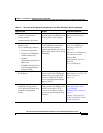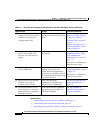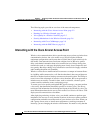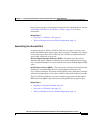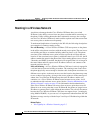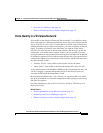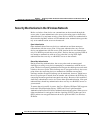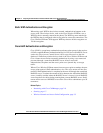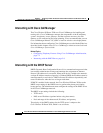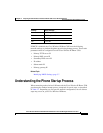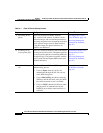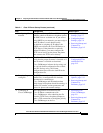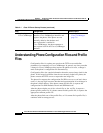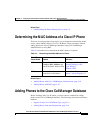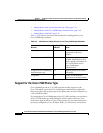
2-7
Cisco Wireless IP Phone 7920 Administration Guide for Cisco CallManager Release 3.3 or Later
OL-3930-02
Chapter 2 Preparing to Install the Cisco Wireless IP Phone 7920 on Your Wireless Network
Interactions with Components in the VoIP Network
Static WEP Authentication and Encryption
When using static WEP in the wireless network, authentication happens at the
access point. The wireless device, such as the Cisco Wireless IP Phone, uses a
WEP key that is manually entered at the phone. The WEP key must match with
the WEP key that is configured at the access point for successful connections. The
Cisco Wireless IP Phone 7920 supports WEP keys that use 40-bit encryption or a
128-bit encryption.
Cisco LEAP Authentication and Encryption
Cisco LEAP is a proprietary authentication and encryption protocol that requires
a LEAP-compliant Remote Authentication Dial-in User Service (RADIUS) server
such as the Cisco Access Control Server (ACS) to provide access to the user
database. LEAP allows wireless devices such as the Cisco Wireless IP Phone and
Cisco Aironet Access Point to mutually authenticate by using a user name and
password through a centralized RADIUS server. After a successful
authentication, the phone and the access point use a dynamic key to encrypt
traffic.
When a Cisco Wireless IP Phone roams from one access point to another, the next
access point requires LEAP authentication, also. The voice stream will not flow
until the LEAP authentication is completed at the next AP through the centralized
RADIUS server. To reduce the amount of delay between the AP and the RADIUS
server, carefully consider where the RADIUS server is located. A local RADIUS
server introduces less delay during roaming than a remote RADIUS server. Small,
remote offices can use a RADIUS server on the Cisco AP to authenticate up to 50
usernames.
Related Topics
• Interacting with Cisco CallManager, page 2-8
• Security, page 1-7
• Wireless Network and Access Point Configuration, page 3-3



